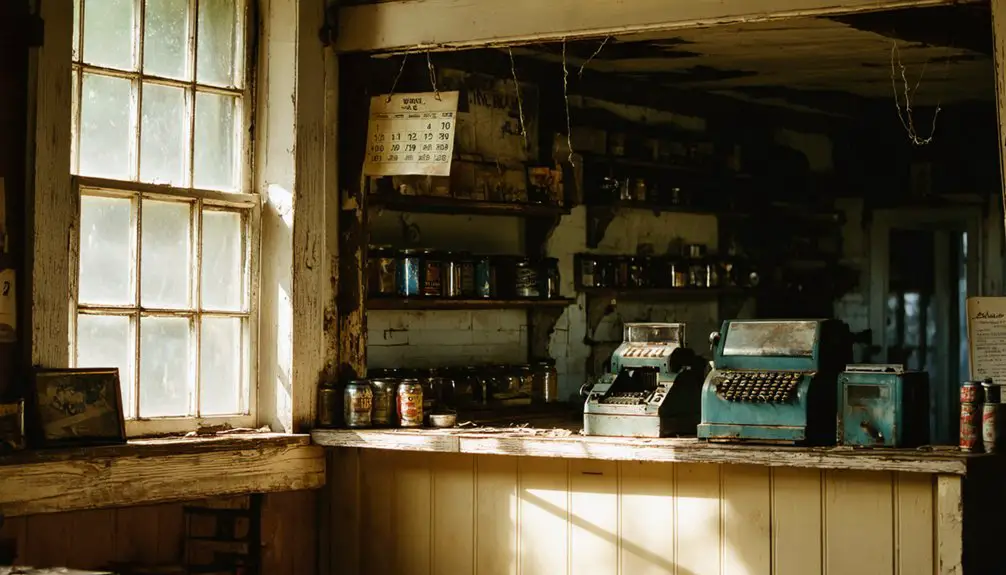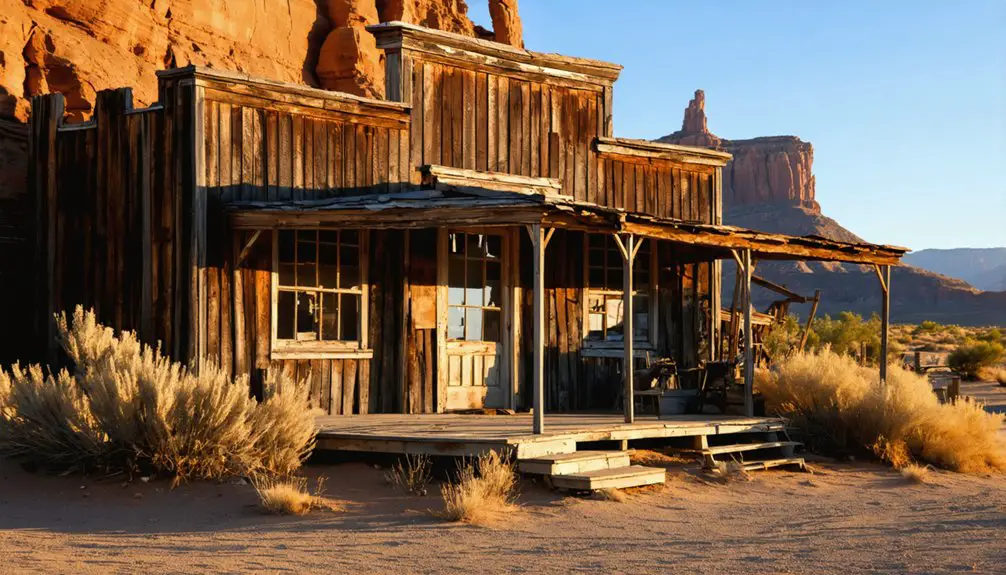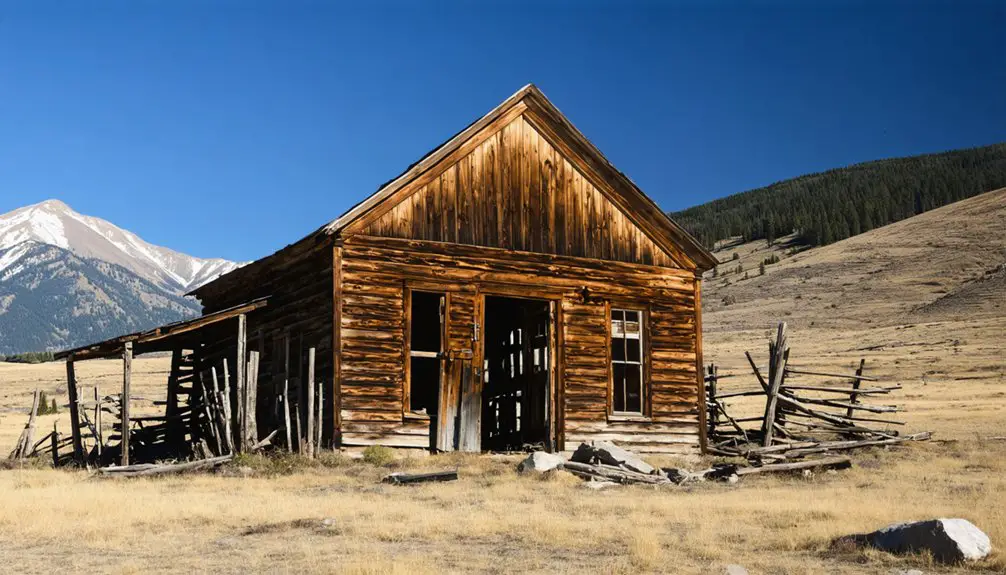You’ll find Bridgeport’s remains three miles east of Dayton, Utah, where Deep Creek meets the Bear River. This once-bustling ranching settlement, established in 1862, thrived around Nathan W. Packer’s ferry operation that transported thousands of tons of freight to Montana’s gold fields. The town featured Charley Crouse’s trading post, a post office, and various businesses until its decline in 1940. The site’s preserved structures and artifacts reveal countless stories of pioneers, traders, and outlaws who shaped this frontier community.
Key Takeaways
- Bridgeport was established near Deep Creek and Bear River, becoming a significant settlement due to Nathan W. Packer’s ferry operations.
- The town featured Charley Crouse’s trading post, a post office, and served as a vital hub for settlers and travelers.
- Economic activity centered around ranching, agriculture, and ferry services transporting 3,000-4,000 tons of freight annually to Montana’s gold fields.
- The post office’s closure in 1940 marked Bridgeport’s decline, with economic shifts and environmental challenges leading to eventual abandonment.
- Today, Bridgeport is recognized on Preservation Utah’s 2024 Endangered Historic Places list, with ongoing efforts to protect its historical structures.
The Rise of a Ranching Settlement
When Nathan W. Packer established his ferry on the Bear River, he sparked the birth of Bridgeport’s unique settlement dynamics.
You’ll find this frontier outpost located three miles east of Dayton, where Deep Creek meets the Bear River. The bustling ferry operations transported an impressive 3,000 to 4,000 tons of freight annually, serving wagons bound for Montana’s gold fields.
Despite the challenging environment of swamps and poor soil, hardy settlers carved out a life here between 1862 and 1879. A Latter-day Saint ward organized regular religious services in residents’ homes. The skilled Elvira Wheeler served the community as both nurse and midwife.
You’ll discover they lived in basic dugouts or log cabins with dirt floors and sod roofs, growing what they could in the difficult terrain. While alfalfa and grain struggled, spring-fed gardens yielded berries, melons, and vegetables, helping sustain the determined residents who made this rugged outpost their home.
Life Along the Green River
Along the verdant banks of eastern Utah’s Green River, you’ll find a striking desert oasis that shaped the region’s early development. The river ecology created a vibrant corridor through the arid landscape, drawing diverse groups seeking freedom and opportunity in the American West. Shoshone and Ute tribes occupied the region long before European explorers arrived.
- You’ll witness the cultural significance of early ferries that served thousands of emigrants, connecting communities and enabling commerce across the untamed waterway. The Spanish Trail crossing located three miles upstream played a vital role in westward migration during the 1830s and 1840s.
- Railroad expansion in the 1880s transformed riverside settlements into bustling hubs of activity.
- Churches, schools, and businesses sprouted along the riverbanks as permanent populations grew.
- The river’s seasonal rhythms dictated local life, from agricultural ventures to the movement of cowboys and sheepherders who relied on river access.
The river’s presence fostered a unique blend of permanent settlers and transient groups, all drawn to its life-giving waters amid the surrounding desert expanse.
Legacy of Charley Crouse
You’ll find Charley Crouse’s lasting impact on Browns Park through his pioneering trading post operations at Bridgeport, where he established a store, saloon, and post office that served both local settlers and travelers along the Green River.
His marriage to Mary Law in 1879 connected him to prominent pioneer families, strengthening his position as a respected ranching leader in the region. Like many others during this era, he participated in the cattle rustling culture that was prevalent throughout Browns Park from 1871 to 1913.
While operating his ranch near Pot Creek, Crouse’s business ventures extended beyond Bridgeport to include a livery stable and saloon in Vernal, demonstrating his entrepreneurial influence throughout northeastern Utah. The Crouse ditch he constructed in 1902 became an essential irrigation system that served properties from Bridgeport and beyond.
Pioneer Trading Post Operations
During the early 1840s, pioneer trading posts emerged as essential lifelines throughout the Bridger region, with Charley Crouse’s establishment becoming a cornerstone of Bridgeport’s economic development.
You’ll find these trading posts strategically positioned near key supply routes, river crossings, and the Oregon Trail, serving as critical hubs for westward expansion. Following the example of Jim Bridger’s guidance, countless traders and emigrants relied on these outposts for survival and success. The rugged terrain challenges faced by pioneers made these trading posts crucial stopping points for repairs and resupply.
- Posts acted as resupply stations for essential provisions, tools, and livestock
- They served as communication centers for news and mail exchange
- Trading posts facilitated commerce between settlers, miners, and indigenous peoples
- They provided necessary services like ferry crossings and banking functions
Crouse’s trading post exemplified the era’s entrepreneurial spirit, bridging the gap between Utah’s resources and Montana’s gold fields while fostering important relationships with local tribes and travelers along established routes.
Family Ranching Leadership
Leadership and tenacity defined Charley Crouse’s legacy in Browns Park, where he established the Livestock Park Ranch and transformed Bridgeport into a thriving ranching hub by 1902.
You’ll find his ranching innovations extended beyond traditional cattle operations – he built an essential bridge across the Green River and developed multiple business ventures including a store, saloon, and livery stable.
His successful Overholt Saloon partnership helped establish his reputation as a prominent local businessman. Crouse tackled significant leadership challenges, balancing the needs of local ranchers with the realities of frontier life, including interactions with outlaws like Butch Cassidy.
His strategic placement of Bridgeport’s post office and trading operations created a critical lifeline for surrounding ranch families. Like the early Pequonnock River settlers of Connecticut, he recognized the importance of waterways for trade and transportation.
Even after his death in 1908, Crouse’s family maintained his entrepreneurial vision, ensuring the ranch’s survival and cementing Bridgeport’s place in Browns Park history.
The John Jarvie Connection
Around 1880, John Jarvie established himself along the Green River in Brown’s Park, creating what would become an essential hub for commerce and community life.
Without formal land ownership until years later, he built a thriving operation that served travelers and locals alike.
The Jarvie murder in 1909 marked a tragic end to his pioneering legacy, though his impact on the region endures.
- You’ll find over 945 Jarvie artifacts excavated from the site, including items from his store, blacksmith shop, and dugout.
- His ferry service marked the crossing point for the region’s first wool shipment.
- He operated a successful distillery, though his moonshine failed to impress a local jury.
- The ranch’s strategic location at a historic ford made it vital for both legal and illicit trade routes.
Daily Life and Commerce

Life in Bridgeport centered around its bustling stage stop, established in 1869, where coaches stopped twice weekly to exchange horses and provide meals to weary travelers.
Commerce patterns revolved around serving these passing traders and settlers, with locals offering essential services at the stop.
Your daily interactions would’ve included encounters with diverse personalities moving along the east-west route, bringing news and goods from distant places.
You’d have witnessed the town’s economic liveliness through its ferry service and bridge crossings, facilitating significant trade movements.
The local sanitarium at Del Rio drew health-seeking visitors, while the race track provided entertainment.
Agricultural activities included hunting pheasants among the Russian olive trees, which had been intentionally introduced.
This vibrant period lasted until 1878, when nearby railroad development redirected the region’s commerce patterns.
Historical Structures and Sites
You’ll discover these notable features of Bridgeport’s past:
- The Jarvie complex showcases typical wood-frame construction of early 20th-century Utah ranching settlements.
- Crouse’s store, saloon, and post office once formed Bridgeport’s bustling center.
- The post office operated from 1902 to 1940, marking the town’s active period.
- The farmstead includes preserved domestic and agricultural outbuildings reflecting frontier ranching life.
Today, interpretive signage guides you through the site’s rich history, while the preserved structures offer a glimpse into Browns Park’s pioneering spirit.
The Path to Abandonment

While Bridgeport once thrived as a small ranching community with essential trading posts and social centers, multiple factors converged to seal its fate as a ghost town.
Economic shifts hit the area hard as ranching became less viable and trade routes changed, pushing younger residents to seek opportunities elsewhere.
You’ll find that environmental impacts, including the challenges posed by the Green River and Jesse Ewing Canyon, made it difficult to sustain long-term settlement.
By 1940, when the post office closed, the town’s decline was evident.
Federal infrastructure projects reshaped the region, while the aging population dwindled without replacement.
As social and economic infrastructure disappeared, remaining residents had little choice but to abandon their homes, leaving Bridgeport to fade into history.
Present-Day Preservation Efforts
Despite Bridgeport’s decline into abandonment, modern preservation efforts have sparked renewed interest in protecting this piece of Utah’s heritage.
You’ll find community engagement at the forefront of these preservation initiatives, with local organizations and government bodies working together to safeguard the site’s historical significance.
- Preservation Utah’s 2024 Endangered Historic Places list highlighted Bridgeport, drawing critical attention to the ghost town’s needs.
- The Historic Preservation Commission holds regular meetings to oversee protection strategies and resource allocation.
- You’re encouraged to participate in educational events and workshops focused on preservation best practices.
- Local volunteer programs support professional restoration work, ensuring the site’s ongoing maintenance.
These coordinated efforts blend historical documentation with physical preservation while managing public access through designated trails and interpretive sites.
Frequently Asked Questions
What Was the Average Temperature and Climate in Bridgeport During Its Peak?
You’d experience a semi-arid climate with seasonal changes from freezing winters (10-20°F) to warm summers (70-90°F), while average temperatures aligned with typical high-altitude Intermountain West patterns.
Were There Any Notable Conflicts Between Native Americans and Bridgeport Settlers?
You’ll find that settler relations were tense during the Black Hawk War (1865-1872), with tribal conflicts spreading through Sanpete County near Bridgeport, leading to raids and defensive fortifications.
What Forms of Entertainment and Recreation Did Bridgeport Residents Enjoy?
You’d enjoy dancing at dance halls, playing local sports like baseball, hunting near Green River, fishing in canyons, gathering at saloons, and attending seasonal festivals with live music.
How Did Residents Handle Medical Emergencies in Such a Remote Location?
You’d rely on local herbal remedies, community caregivers, and self-treatment since there weren’t telemedicine solutions. For serious emergencies, you’d face long journeys by horse to distant towns with doctors.
Did Any Famous Outlaws or Historical Figures Ever Visit Bridgeport?
You won’t find any verified outlaw legends or historical visits from famous figures here. While nearby Browns Park attracted some notorious characters, no records show well-known outlaws stopping in this ranching settlement.
References
- https://www.familysearch.org/en/wiki/Utah_Ghost_Towns
- https://en.wikipedia.org/wiki/Bridgeport
- https://allthatsinteresting.com/rockport-utah-ghost-town
- https://www.ksl.com/article/50243431/utah-ghost-town-reappears-as-a-result-of-drought
- https://www.treasurenet.com/threads/bridgeport-utah-ghost-town-1902-1940-in-daggett-county-browns-park.569634/
- https://mendonutah.org/history/cv/bridgeport.htm
- http://www.franklincountyhist.org/bridgeport.html
- https://historytogo.utah.gov/cowboys-cattle/
- https://www.uen.org/utah_history_encyclopedia/l/LIVESTOCK_INDUSTRY.shtml
- https://npshistory.com/publications/blm/cultresser/ut/7/chap2.htm



